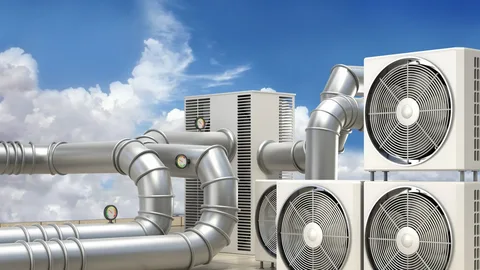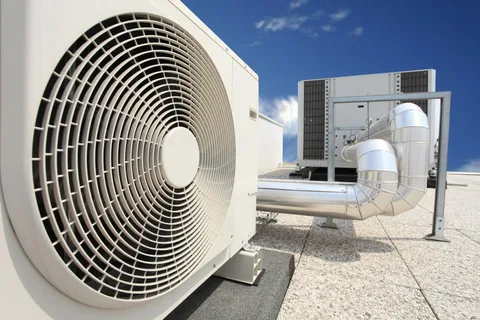In the pursuit of creating a comfortable, healthy, and energy-efficient living space, the role of a home-ventilation system cannot be overstated. From controlling indoor air quality to regulating temperature, these systems play a pivotal role in ensuring our homes are not only livable but also conducive to our well-being. Home Ventilation System is the backbone of maintaining high indoor air quality. By effectively managing this system, you can significantly improve the comfort and healthiness of your living space.
Understanding the House Ventilation System
A house ventilation system functions as the lungs of your home, constantly working to ensure that indoor air is exchanged with fresh outdoor air. This process is crucial for diluting and removing indoor pollutants, excess moisture, and odorous air, which can accumulate in our living spaces. Depending on the specific needs and design of a home, there are several types of ventilation systems available, including exhaust systems that remove air from inside to the outside, supply systems that bring fresh air into the home, balanced systems that simultaneously remove indoor air while bringing in outdoor air, and energy recovery systems that retain energy from the exchanged air to improve efficiency.
Each system type offers unique advantages and operates under different principles to maintain the quality and comfort of indoor environments. Selecting the right ventilation system involves understanding these distinctions, alongside the specific demands of your living space, to ensure optimal air quality and energy efficiency.
Benefits of Residential Ventilation Systems
Residential ventilation systems serve as a cornerstone in creating healthier living spaces. They are instrumental in maintaining comfortable indoor temperatures and ensuring the removal of airborne contaminants, including allergens and pollutants, thus significantly lowering the likelihood of respiratory issues. Additionally, these systems can be pivotal in energy conservation efforts.
By aiding in the control of indoor climates, they reduce the dependency on air conditioning units during warm months and heating systems in cooler times, which can lead to noticeable savings on energy bills. The prevention of moisture buildup is another critical advantage, as it helps in averting the potential for mold growth and structural damage, preserving the integrity of the home.
By facilitating a constant influx of fresh air and the expulsion of stale air, they also play a crucial role in odor management, keeping the home environment fresh and inviting. In essence, the array of benefits offered by residential systems extends far beyond simple air exchange, touching on aspects of health, comfort, and financial savings, making them an indispensable feature of modern living spaces.
 Combating Humidity and Reducing Mold Growth
Combating Humidity and Reducing Mold Growth
Mitigating excessive humidity within your residence is a pivotal advantage of utilizing a robust home-ventilation system. Elevated humidity levels are a prime catalyst for the proliferation of mold and mildew, posing significant health risks and potentially compromising the structural integrity of buildings. Home-ventilation systems adeptly regulate indoor humidity, creating an environment that is less hospitable to mold and mildew growth.
This proactive approach not only preserves the health of occupants by minimizing exposure to harmful spores and bacteria but also safeguards your home against the detrimental effects of moisture accumulation. By ensuring a consistent exchange of damp indoor air with drier, fresh outdoor air, these systems effectively maintain an equilibrium that is unfavorable for mold development.
This strategic humidity control is essential for maintaining a healthy and resilient living space, free from the concerns of mold-induced damage and the associated health implications. In addition to mold prevention, a well-regulated indoor environment also deters dust mites, another common allergen, and promotes overall indoor air quality. Hence, an effective ventilation system not only protects your property, but it is also an investment in the wellness and comfort of your household.
Enhancing Indoor Comfort and Odor Control
The seamless operation of a home-ventilation system plays a critical role in elevating the ambiance of your living spaces. By facilitating the exchange of indoor air laden with odors from cooking, pets, and other sources, with fresh, outdoor air, these systems directly impact the freshness and overall sensory experience of your home environment. This continuous airflow not only dispels unwanted smells but also contributes to a sense of well-being and comfort for occupants.
The effectiveness of a ventilation system in managing indoor air quality is also beneficial in eliminating the lingering presence of tobacco smoke and other hard-to-remove odors, ensuring your home maintains a neutral and pleasant aroma. Ventilation systems, therefore, stand as a key component in enhancing the livability and enjoyment of your indoor spaces, devoid of reliance on artificial fragrances or other temporary solutions to manage odors.
Better still, modern ventilation systems can be easily integrated with smart home devices, enabling real-time control and monitoring of indoor air quality for optimized comfort and freshness. This way, a healthy and pleasing home environment is easily achievable and maintainable.
Improving Energy Efficiency and Reducing Costs
Activating an efficient home-ventilation system can significantly decrease energy expenses by optimizing indoor air conditions and minimizing the dependency on heating and cooling appliances. These systems manage the indoor climate effectively, ensuring that air temperature remains stable without excessive use of external heating or cooling sources, thus conserving energy. Advanced options, such as heat recovery ventilators, exemplify this by capturing warmth from outgoing air and recycling it to heat incoming fresh air.
This process not only maintains a comfortable indoor temperature but also cuts down on the energy required to heat new air from outside, leading to substantial savings on utility bills. By intelligently integrating such systems, homeowners can achieve a balance between maintaining optimal air quality and controlling energy use, making the home more eco-friendly while also easing the burden on their wallets.
This strategic approach to ventilation proves that with the right system in place, enhancing air quality and comfort does not have to come at the expense of higher energy costs. Indeed, not only do these systems provide long-term cost savings, but they also add to the overall value of the property by making it more energy efficient and environmentally sustainable. Such an upgrade in a home can be a game-changer in the real estate market, attracting potential buyers seeking energy-efficient living spaces.
Home Ventilation System Design
Home Ventilation System Design begins with the careful evaluation of your home’s architecture and geographic location. The configuration of your house, the climate and local air quality all play a role in defining the right system. For instance, homes in high-humidity climates may require more robust moisture control, while houses in busy urban areas might benefit from advanced air purification capabilities. By tailoring to the specific challenges your house faces, they ensure a ventilation system that works efficiently and effectively for your unique environment.
To navigate these complexities, collaboration with a ventilation expert is invaluable. They can offer insights into the most suitable types of systems whether exhaust, supply, balanced, or energy recovery that align with both the homeowner’s needs and environmental demands. Moreover, these professionals ensure the system adheres to local building regulations, guaranteeing not just comfort but also compliance.
Integrating advanced technologies, such as HEPA filters or smart thermostats, further personalizes the system, enhancing its ability to provide clean, comfortable air precisely where and when it’s needed. In essence, a thoughtfully designed home-ventilation system is the result of considering a myriad of factors, expert guidance, and the latest in air quality technology.
Balancing Ventilation with Air Quality
Achieving the perfect equilibrium between ventilation and indoor air quality is a nuanced endeavor that requires careful consideration. It’s about ensuring that the fresh air entering your home doesn’t just replace the stale air but is also clean and free from pollutants. Incorporating advanced filtration technologies, such as HEPA filters, into your home-ventilation system is a proactive step towards this balance.
These filters are adept at capturing a wide array of airborne particles, including pollen, dust mites, and other allergens that can compromise air quality. Additionally, considering air purification systems as part of your ventilation setup can further enhance the cleanliness of the air inside your home. Such systems work in tandem with your ventilation to not only bring in fresh air but also to ensure that this air is purified to the highest standards.
Regular maintenance of these filtration and purification components is crucial to sustain their effectiveness over time. This approach, focusing on both the influx of fresh air and the purification of that air, ensures a healthier indoor environment without sacrificing ventilation efficiency.
The Importance of Home Ventilation Systems Australia
Home Ventilation Systems Australia is particularly important due to the nation’s diverse climate. Whether it’s the tropical climate of the north, the dry heat of the central desert, or the cool temperatures in the south, a well-functioning system ensures a comfortable, healthy living environment all year round.
In regions experiencing extreme heat, for instance, ventilation systems play a crucial role in expelling hot, stale air from the home, thereby reducing the reliance on air conditioning units and subsequently lowering energy consumption. Conversely, in cooler, more humid areas, these systems are instrumental in preventing moisture buildup, a common precursor to mold and mildew, which can have adverse health effects and contribute to structural damage over time.
Australia’s urban landscape, with its densely populated cities and increasing pollution levels, further underscores the need for efficient home ventilation. Here, the ability of a ventilation system to filter out pollutants and ensure a supply of fresh, clean air is paramount in safeguarding the health of residents. Additionally, Australian building codes and environmental standards emphasize sustainability and energy efficiency, advocating for ventilation solutions that not only enhance air quality but also contribute to the conservation of energy.
FAQS
Q1: How Often Should I Have My Home Ventilation System Serviced?
A1: It is recommended to service your home-ventilation system at least once a year to ensure it operates efficiently and maintains optimal air quality. However, the frequency can depend on specific factors such as system type, usage, and environmental conditions.
Q2: Can Installing A Ventilation System Reduce Energy Costs?
A2: Yes, an efficient home-ventilation system can significantly reduce energy costs by optimizing indoor climate control and reducing the need for heating and cooling appliances. Systems with energy recovery features are particularly effective at conserving energy.
Q3: Will A Ventilation System Make My Home Too Drafty?
A3: No, when properly installed and calibrated, a ventilation system will not make your home feel drafty. Modern systems are designed to ensure a comfortable flow of fresh air without causing uncomfortable drafts.
Conclusion
Embracing the advantages of a well-implemented home ventilation system transcends mere architectural design it represents a commitment to fostering an environment that promotes health, comfort, and economic efficiency. Through a nuanced understanding of the diverse types of ventilation solutions available and their respective benefits, homeowners are equipped to make informed decisions that enhance the livability of their spaces. Optimal utilization of these systems not only mitigates indoor air pollutants and regulates temperature but also contributes to significant energy savings.
| Other Good Articles to Read |
| Skank Blogs |
| Unreal Blogs |
| Tba Blogs |
| All City Forums |
| Dany Blogs |
| Refuge Blogs |
| The Music Blogs |
| Key Forums |
| The Big Blog Theory |
| Joe Blogs |
| Blogs 4 Me |
| Blogs Emon |
| Related Business Listings |
| Contact Directory |
| Local Business Profiles |

